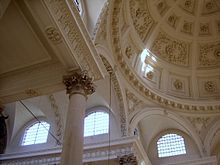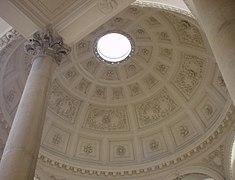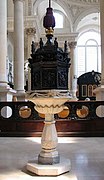St Stephen Walbrook
| St Stephen Walbrook | |
|---|---|
 | |
 | |
| Location | 39 Walbrook,Walbrook,LondonEC4N 8BN |
| Country | United Kingdom |
| Denomination | Church of England |
| Previous denomination | Roman Catholic |
| Website | https://ststephenwalbrook.net/ |
| Architecture | |
| Heritage designation | Grade Ilisted building |
| Architect(s) | SirChristopher Wren |
| Style | Baroque |
| Administration | |
| Diocese | London |
St Stephen Walbrookis a church in theCity of London,part of theChurch of England'sDiocese of London.The present domed building was erected to the designs of SirChristopher Wrenfollowing the destruction of its medieval predecessor in theGreat Fire of Londonin 1666. It is located in Walbrook, next to theMansion House,and near toBank and Monument Underground stations.
Early history
[edit]The original church of St Stephen stood on the west side of the street today known as Walbrook and on the east bank of theWalbrook,[1]once an important fresh water stream for the Romans running south-westerly across the City of London from the City Wall near Moorfields to the Thames. The original church is thought to have been built directly over the remains of a RomanMithraicTemple following a common Christian practice ofhallowing former heathen sitesof worship.[2]
The church was moved to its present higher site on the other side of Walbrook Street, still on the east side of the River Walbrook[3](later diverted and concealed in a brick culvert running under Walbrook Street and Dowgate Hill on a straightened route to the Thames),[4]in the 15th century. In 1429Robert Chichele,acting as executor of the will of the formerLord Mayor,William Standon,had bought a piece of land close to theStocks Market(on the site of the laterMansion House) and presented it to the parish.[3]Several foundation stones were laid at a ceremony on 11 May 1429,[5]and the church was consecrated ten years later, on 30 April 1439.[6]At 125 feet (38 m) long and 67 feet (20 m) wide, it was considerably larger than the present building.[7]
The church was destroyed in the Great Fire of London in 1666.[3]It contained a memorial to the composerJohn Dunstaple.The wording of the epitaph had been recorded in the early 17th century, and was reinstated in the church in 1904, some 450 years after his death.[citation needed]The nearby church ofSt Benet Sherehog,also destroyed in the Great Fire, was not rebuilt; instead its parish was united with that of St Stephen.[3]
Wren's church
[edit]

The present building was constructed between 1672 and 1679[8]to a design bySir Christopher Wren,at a cost of £7,692.[7]The mason was Thomas Strong brother ofEdward Strong the Elderand the spire is by Edward Strong the Younger.[9]It is rectangular in plan,[10]with a dome and an attached north west tower. Entry to the church is up a flight of sixteen steps, enclosed in a porch attached to the west front.[3]Wren also designed a porch for the north side of the church. This was never built, but there once was a north door, which was bricked up in 1685, as it let in the offensive smells from the slaughterhouses in the neighbouring Stocks Market.[11] The walls, tower,[12]and internal columns[3]are made of stone, but the dome is of timber[12]and plaster with an external covering of copper[13]
The 63 feet (19 m) high dome is based on Wren's original design forSt Paul's,and is centred over a square of twelve columns[14]of theCorinthian order.[3]The circular base of the dome is not carried, in the conventional way, bypendentivesformed above the arches of the square, but on a circle formed by eight arches that spring from eight of the twelve columns, cutting across each corner in the manner of theByzantinesquinch.[14]This all contributes to create what many consider to be one of Wren's finest church interiors. SirNikolaus Pevsnerlists it as one of the ten most important buildings in England.
The contemporary carved furnishings of the church, including the altarpiece and Royal Arms, the pulpit and font cover, are attributed to the carpenters Thomas Creecher and Stephen Colledge, and the carversWilliam Newmanand Jonathan Maine.[15]
In 1760 a new organ was provided byGeorge England.
In 1776 the central window in the east wall was bricked up to allow for the installation ofDevout Men Taking Away the Body of St Stephen,a painting byBenjamin West,which the rector, Thomas Wilson, had commissioned for the church.[16][17]The next year Wilson set up in the church a statue ofCatharine Macaulay,(then still alive) whose political ideas he admired. It was removed after protests.[18]The east window was unblocked, and the picture moved to the north wall, during extensive restorations in 1850.[19]
Recent history
[edit]
The church suffered slight damage from bombing during theLondon Blitzof 1941 and was later restored. In 1954, the united parishes ofSt Mary BothawandSt Swithin London Stone(merged in 1670) were themselves united with the parish of St Stephen.
The church was designated a Grade Ilisted buildingon 4 January 1950.[13]
In 1953 theSamaritanscharity was founded by the rector of St Stephen's, DrChad Varah.The first Samaritans branch (known as Central London Branch) operated from a crypt beneath the church before moving to Marshall Street inSoho.In tribute to this, a telephone is preserved in a glass box in the church. The Samaritans began with this telephone, and today the voluntary organisation staffs a 24-hour telephone hot-line for people in emotional need.
In 1987, as part of a major programme of repairs and reordering,[17]a massive white polished stonealtarcommissioned from the sculptorHenry Mooreby churchwardenPeter Palumbowas installed in the centre of the church.[20]Its unusual positioning required the authorisation of a rare judgement of theCourt of Ecclesiastical Causes Reserved.[21]In 1993 a circle of brightly colouredkneelersdesigned byPatrick Heronwas added around the altar.[22]
Benjamin West'sDevout men taking away the body of St Stephen,previously hung on the north interior wall, was put into storage following the reordering. This decision was controversial, as the initial removal of the painting was illegal.[23]In 2013 the church was given permission to sell the painting to a foundation, despite opposition from the London Diocesan Advisory Committee for the Care of Churches, and by the Church of England's Church Buildings Council.[23]Prior to the painting's export, a temporary export bar was placed on it to give it a last chance to stay in the UK.[24]The foundation has since loaned it to theMuseum of Fine Artsin Boston, which has undertaken restoration work on the painting.[17][25]
On 14 July 1994, the church was the venue for the wedding ofLady Sarah Armstrong-JonestoDaniel Chatto.[26]
At the time of his retirement in 2003, at the age of 92, Dr Chad Varah was the oldest serving incumbent in the Church of England.[27]
Rectors
[edit]- Peter 1301–1302[28]
- Hugh de Marny 1315
- Willian de Stansfield 1325–1327
- Thomas Blundell 1350–1359
- Robert Eleker 1351–1385
- John Brown 1391–1395
- John Horewood 1395–1396
- Henry Chichele1396–1397. LaterArchbishop of Canterbury
- John Horewood 1397–1400
- John Beachfount 1400–1403
- Radman died 1419
- William Rock 1422. Resigned
- Thomas Southwell1428–1440
- William Trokill 1440–1474
- Robert Rous 1474–1479
- William Sutton 1479–1502
- John Young 1502
- John Kite1522–1534
- Elisha Bodley 1534
- Thomas Becon
- William Ventris 1554–1556
- Henry Pendleton1556–1557
- Humphrey Busby 1557–1558
- Philip Pettit 1563 or 1564
- John Bendale 1563 or 1564
- Henry Wright 1564–1572
- Henry Trippe 1572–1601
- Roger Fenton1601–1616
- Thomas Muriel 1615–1625
- Aaron Wilson 1625–1635
- Thomas Howell1635–1641
- Michael Thomas 1641–1642
- Thomas Warren 1642
- Thomas Watson1642–1662. Sequestered.
- Robert Marriott 1662–1689
- William Stonestreet 1689–1716
- Joseph Rawson 1716–1719
- Joseph Watson 1719–1737
- Thomas Wilson 1737–1784
- George S. Townely 1784–1835
- George Croly1835–1861. Also a poet and novelist.
- William Windle 1861–1899
- Robert Stuart de Corcy Laffan 1899–1927[29]
- Charles Clark 1927–1940[30][31]
- Frank Gillingham1940–1953[32]
- Chad Varah1953–2003[33]
- Peter Delaney2004–2014. Aspriest in charge[34]
- Jonathan Evens 2015–2018. As priest in charge
- Stephen Baxter 2018–
Burials
[edit]
- Sir Rowland Hill,ofSoultonpublisher of theGeneva Bible,styled "First ProtestantLord Mayor of London":his monument was lost in theGreat Fire of Londonbut was restated atHawkstone
- John Dunstaple,musician
- Elizabeth Jekyll(1624-1653) diarist[35]
- John Vanbrugh,architect
The nearestLondon Underground stationisBank.
Gallery
[edit]-
Interior of St Stephen Walbrook
-
St Stephen Walbrook Ceiling 21st century
-
The organ over the west door
-
The wooden pulpit with its huge tester
-
The covered font
-
The dome and lantern seen from outside
See also
[edit]Notes
[edit]- ^White 1900, p.285
- ^"Early History of St Stephen Walbrook".St Stephen Walbrook. Archived fromthe originalon 12 November 2007.Retrieved10 April2009.
- ^abcdefgGodwin, George; John Britton (1839)."St Stephen's, Walbrook".The Churches of London: A History and Description of the Ecclesiastical Edifices of the Metropolis.London: C. Tilt.Retrieved18 March2012.
- ^White 1900, p.63
- ^"The City of London Churches: monuments of another age" Quantrill, E; Quantrill, M p90: London; Quartet; 1975
- ^White 1900, p.288
- ^abWhite 1900, p.296
- ^"The City Churches" Tabor, M. p102:London; The Swarthmore Press Ltd; 1917
- ^Dictionary of British Sculptors 1660–1859 by Rupert Gunnis
- ^Britton and Pugin 1825, p34
- ^Perks, Sydney (1922).The History of the Mansion House.Cambridge University Press. p.119.
- ^abBritton and Pugin 1825, p37
- ^abHistoric England."Details from listed building database (1285320)".National Heritage List for England.Retrieved23 January2009.
- ^abBetjeman, John (1967).The City of London Churches.Andover: Pitkin.ISBN0-85372-112-2.
- ^S. Bradley and N. Pevsner,London: The City Churches(The Buildings of England), (Yale University Press, London and New Haven 2002), pp. 129–30.
- ^White 1900, p.386
- ^abc"Anglican court says Benjamin West altarpiece can go to Boston".The Art Newspaper.Retrieved1 January2015.
- ^White 1900, p.387
- ^White 1900, p.299
- ^Tucker, T. (2006).The Visitors Guide to the City of London Churches.London: Friends of the City Churches.ISBN0-9553945-0-3.
- ^Re St Stephen Walbrook[1987] 2 All ER 578
- ^"Patrick Heron – St Stephen Walbrook".ststephenwalbrook.net.
- ^abGrosvenor, Bendor."Church of England to sell important Benjamin West?".Art history news.Retrieved6 November2015.
- ^"Taking the body of St Stephen overseas".GOV.UK.
- ^"Conservation in Action: Benjamin West".Museum of Fine Arts, Boston.Retrieved1 January2015.
- ^"Looking back at the nuptials of Princess Margaret's daughter, Lady Sarah Chatto, on her wedding anniversary".Tatler.London. 14 July 2021.Retrieved17 June2022.
- ^"Obituaries – The Reverend Prebendary Chad Varah".The Telegraph. 9 November 2007.Retrieved19 August2016.
- ^Rectors to 1904 fromWhite, J. G. (1904).History of the Ward of Walbrook in the City of London.London: Privately printed. p. 338.;others as indicated
- ^"Mr. De Courcy Laffan".The Times (London, England).18 January 1927. p. 16.
- ^"Ecclesiastical News".The Times (London, England).9 November 1927. p. 17.
- ^"Church Times:"Clerical Obituary", 26 January 1940, p 67 ".Retrieved4 October2021.
- ^"Church Times:"Clerical Obituary", 10 April 1953, p 280 ".Retrieved4 October2021.
- ^"Obituary".The Independent.10 November 2007.Archivedfrom the original on 24 May 2022.Retrieved19 August2016.
- ^"The Venerable Peter Delaney MBE;".Trust for London. Archived fromthe originalon 24 April 2012.Retrieved9 July2012.
- ^Clarke, Elizabeth R. (23 September 2004)."Jekyll, John and Elizabeth et al".Oxford Dictionary of National Biography.Vol. 1 (online ed.). Oxford University Press.doi:10.1093/ref:odnb/67136.ISBN978-0-19-861412-8.(Subscription orUK public library membershiprequired.)
References
[edit]- Britton, John; Pugin, A. (1825).Illustrations of the Public Buildings of London: With Historical and Descriptive Accounts of each Edifice.Vol. 1. London.
- White, J.G. (1904).History of the Ward of Walbrook in the City of London.London: Privately printed.
External links
[edit]- Christopher Wren church buildings in London
- Church of England church buildings in the City of London
- 17th-century Church of England church buildings
- English Baroque church buildings
- Church buildings with domes
- Rebuilt churches in the United Kingdom
- Diocese of London
- Grade I listed churches in the City of London
- Churches in the City of London







